Olympus M.ZUIKO ED 75-300mm f/4.8-6.7
Olympus M.ZUIKO ED 75-300mm f/4.8-6.7 Performance
At 75mm, sharpness in the centre of the frame is limited, with the lens actually performing better towards the edges at all apertures. Sharpness across the frame is good at f/4.8 and improves to very good levels when stopped down to f/5.6.At 150mm, sharpness is excellent across the frame from maximum aperture and peak sharpness across the frame is achieved between f/5.6 and f/8.
Finally at 300mm, sharpness levels drop a little, but they still just reach good levels across the frame at maximum aperture. Stopping down to f/8 results in peak sharpness for this focal length, with very good clarity in the centre.
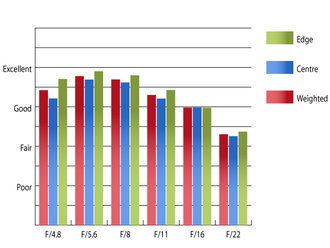 Olympus 75-300mm MTF@75mm | 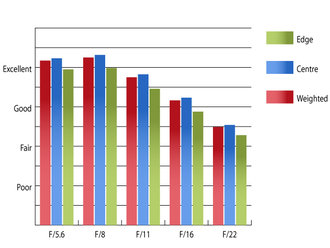 Olympus 75-300mm MTF@150mm |
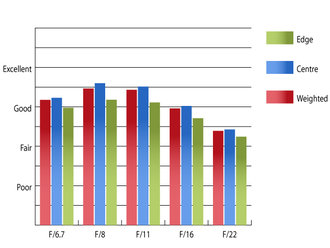 Olympus 75-300mm MTF@300mm | How to read our chartsThe blue column represents readings from the centre of the picture frame at the various apertures and the green is from the edges. Averaging them out gives the red weighted column.The scale on the left side is an indication of actual image resolution. The taller the column, the better the lens performance. Simple. For this review, the lens was tested on a Panasonic Lumix GF3 using Imatest. |
Chromatic aberrations towards the edges of the frame are relatively high throughout the zoom range, peaking at 150mm, where fringing can exceed 1.5 pixel widths. This amount of fringing will almost certainly require correction in image editing software afterwards, especially along high contrast edges towards the edges of the frame.
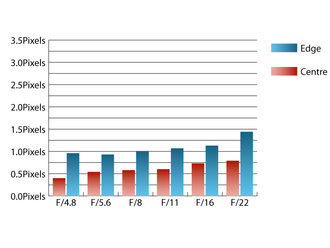 Olympus 75-300mm CA@75mm | 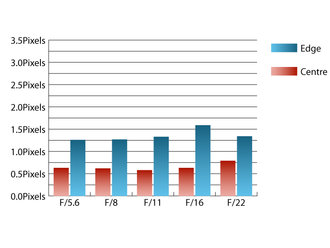 Olympus 75-300mm CA@150mm |
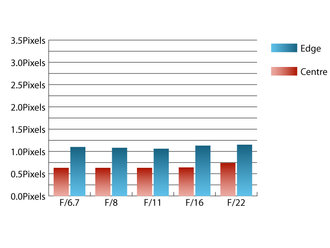 Olympus 75-300mm CA@300mm | How to read our chartsChromatic aberration is the lens' inability to focus on the sensor or film all colours of visible light at the same point. Severe chromatic aberration gives a noticeable fringing or a halo effect around sharp edges within the picture. It can be cured in software.Apochromatic lenses have special lens elements (aspheric, extra-low dispersion etc) to minimize the problem, hence they usually cost more. For this review, the lens was tested on a Panasonic Lumix GF3 using Imatest. |
Falloff of illumination towards the corners of the frame isn't too much of an issue, although given the modest maximum aperture and the fact that the corners are around one stop darker than the image centre throughout the zoom range, it could perform better in this area. Stopping the lens down by a stop results in visually uniform illumination throughout the zoom range.
Distortion is well controlled and consistent throughout the zoom range with Imatest detecting between 0.35% and 0.46% pincushion distortion. This low level shouldn't pose many issues, but if absolutely straight lines are paramount what little distortion there is should be relatively straightforward to correct as it is uniform across the frame.
Add your message
Login required
Please login here or if you've not registered, you can register here. Registering is safe, quick and free.
Please login here or if you've not registered, you can register here. Registering is safe, quick and free.
photodo Stats
1102 lenses
428 MTF tests
74 in-depth photodo reviews
100+ users join each day
Help the lens community by reviewing or rating a lens today via our lens search
428 MTF tests
74 in-depth photodo reviews
100+ users join each day
Help the lens community by reviewing or rating a lens today via our lens search
Latest Lens Reviews
- Chinon 28mm f/2.8 Vintage Lens Review
- Canon EF 70-200mm f/4L IS II USM Lens Review
- Samyang AF 85mm f/1.4 EF Review
- Sigma 70mm f/2.8 DG Macro Art Review
- Samyang AF 24mm f/2.8 FE Review
- Meike 50mm f/1.7 Review
- Tamron 70-210mm f/4 Di VC USD Review
- Lensbaby Burnside 35mm f/2.8 Review
- Asahi Super Takumar 50mm f/1.4 Review
- Asahi Super-Multi-Coated Takumar 135mm f/3.5 Review
